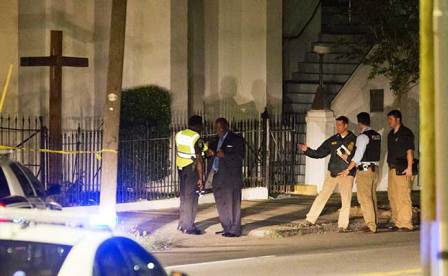Though the cause of Tuesday’s blaze remains uncertain, along with some of the earlier fires since the massacre at Charleston’s Emanuel AME Church, they evoked a painful history that still haunts African American congregations.
Just hours before the Mount Zion fire broke out, the NAACP warned black churches to “take necessary precautions” against the threat of attack.
Mount Zion itself has been torched before — in 1995, by two young white men with ties to the Ku Klux Klan. And if Tuesday’s fire turns out to have been purposefully set, it will be at least the third arson at an African American church since last month’s massacre at Emanuel AME in Charleston, S.C.
Officials are still looking into why they were started and so far none have been determined to be hate crimes. But the fact that a hate crime, for many, is the first thing that comes to mind when a black church burns — a half century after the Jim Crow era — remains haunting.
Since at least 1822, when the first recorded burning of a black church occurred in South Carolina, church arson has been the default response of racists frustrated with progress — or even the faint specter of progress — on civil rights. More than even lynching, burning houses of worship remains a go-to weapon in hate groups’ arsenal. Torching churches such as Mount Zion persisted decades after the passage of the Civil Rights Act and the Voting Rights Act, 100 years after Booker T. Washington dined at the White House and 150 years after the end of the Civil War.
What’s the enduring appeal of this very specific act of terror for those who wish to express hate?
The reason black churches remain a target: Because black churches have always remained a symbol of hope in the darkness of American racism and a source of leadership, political and religious, in the African American community.
Though it may seem the black church has always been a part of American culture — as essential as the Fourth of July or “The Star-Spangled Banner” — it was not always so. When human beings were held in servitude and meetings among slaves were banned, founding a black church was considered an act of rebellion.
Case No. 1: The founding of the church that would became Emanuel AME, the church allegedly targeted by Dylann Storm Roof last month.
“The formation of the African Church in Charleston was a rebellious act of revolutionary proportions,” historian Bernard Powers wrote in “Black Charlestonians: A Social History.” “… The city authorities recognized the full import of the initiatives taken by this group of slaves and free blacks and responded with harassment.”
Like many black churches, Charleston’s African Church saw a tragic end; it was razed by city authorities in the 1820s after a purported slave plot, and was not reborn until Reconstruction. Though such churches remained a constant target, they persisted, weaving themselves into not just into the fabric of African American culture, but into the social fabric of the United States.
During the early years of the black church in the South, when most congregants were enslaved and the rest still subject to the restrictive racism then the law of the land, Christianity offered solace and inspiration to African American worshippers. In the introduction to the award-winning digital library collection “The Church in the Southern Black Community,” professor Laurie F. Maffly-Kipp of the University of North Carolina at Chapel Hill explained how black Americans converted to Methodist and Baptist traditions around the turn of the 19th century.
“Clergy within these denominations actively promoted the idea that all Christians were equal in the sight of God, a message that provided hope and sustenance to the slaves,” she wrote.
More about:
















































